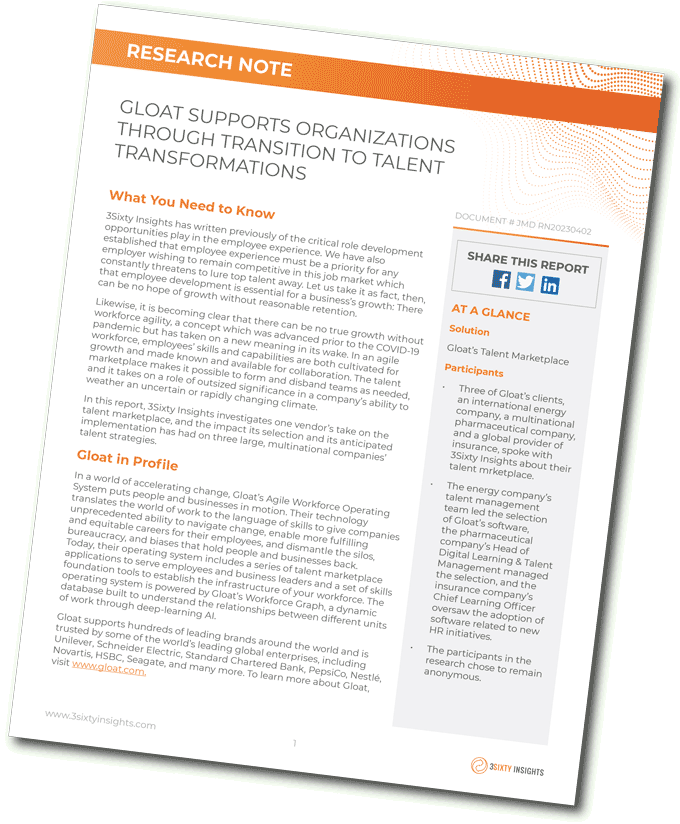Unpacking today’s winning talent transformations with Jennifer Dole
A Q&A on what goes into implementing a talent marketplace with 3Sixty Insights’ Principal Analyst Across every industry and region, businesses are coming to the same conclusion: talent marketplaces are the foundation for successful operating models. Now that 85% of executives believe work must be organized in more agile ways, leaders are looking to

A Q&A on what goes into implementing a talent marketplace with 3Sixty Insights’ Principal Analyst
Across every industry and region, businesses are coming to the same conclusion: talent marketplaces are the foundation for successful operating models. Now that 85% of executives believe work must be organized in more agile ways, leaders are looking to these next-generation technological innovations to help their companies become more adaptive.
While research highlights talent marketplaces’ diverse benefits—including improvements in job satisfaction, engagement, and retention—uncertainty about the operational process involved with implementing a talent marketplace often holds companies back from reaping these advantages.
To prevent such unknowns from hindering talent transformation journeys, 3Sixty Insights Principal Analyst Jennifer Dole set out to shed light on the decision process that goes into implementing this innovative technology. Following the publication of her talent marketplace report, we sat down with her to learn more about her research process, advice for HR leaders looking to implement a talent marketplace, and best practices for gaining buy-in and budget.
Let’s go back to the beginning. What was your goal when writing the report and how did you find the customers you featured?
JD: As an industry analyst, I’m always curious about how traditional talent practices are being disrupted by new technology. I decided to dive deeper into some innovative solutions by exploring customer stories around how they are gaining budget and buy-in for their investment in a talent marketplace.
So I posted on LinkedIn, searching for volunteers who were willing to share their experiences related to talent marketplace technology. I was specifically looking for people who had just made the decision to invest in a platform. While there were several vendors who wanted to tell their stories, what caught my attention was the Gloat customers who immediately reached out with lots of enthusiasm. Gloat wasn’t involved, but your customers raised their hands and wanted to tell their stories, which was unique.
What happened next?
JD: I went to the three customers that reached out on LinkedIn and set up hour-long interviews to learn more about how they got budget and buy-in. I spoke with talent and learning leaders at an energy company, an insurance company, and a pharmaceutical company. Two organizations had just signed their contracts and the third was expanding from a pilot to something more enterprise. So I weaved their stories together to create a comprehensive report that sheds light on their transformations and the power of Gloat.
When you started interviewing these organizations, how did their stories about getting budget compare?
JD: The people who raised their hands to be interviewed were from different industries and different departments within HR, but in essence, they all said similar things about their journeys to get to Gloat. There were three findings that really stood out to me:
- Outdated talent practices and talent stacks
Many companies already automated talent processes to ease administrative burdens, but innovations in technology are now driving the need for exponential value beyond automation. - Shifting HR conversations
Traditionally, each customer had conversations around delivering improved services for onboarding, recruiting, and performance management. But now HR discussions are centered around delivering business value and topics like the future of work. Technology is enabling HR to play a more strategic role in driving organizational success, and as a former HR practitioner, that’s what we’re aiming for. - Lack of internal employee insights
Most organizations knew more about their external candidates’ aspirations and skills than their own employees. That gap has consequences. As organizations were looking to do a better job of matching internal employees with opportunities, being able to gain deeper insights into peoples’ skills and aspirations emerged as a necessity for tapping into talent more effectively.
And what about gaining buy-in, did you see any similarities in how various organizations got leadership on board with their talent marketplace visions?
JD: Once again, there were a few overarching themes that stood out to me, including:
- Looking beyond HCMs
While traditional systems often play a vital role in HR operations, they might not be able to drive the level of change required to do what’s needed for the future of work. These point solutions providers go deeper, while HCMs go broader. At a time when many people are thinking about reducing their tech stack due to economic uncertainty, HR leaders are making the case that these solutions are what they need. - Piloting for movement, not awareness
For the organization that was further along in its talent marketplace journey, piloting had given them the opportunity to not just test the technology but to showcase how transforming talent management practices could deliver better business outcomes. That created more demand for the technology and sped up the transition from pilot to enterprise. - Searching for support and guidance
When organizations are going through this process they’re seeking a partner who can enhance employee experience and support cultural shifts. They looked beyond features and functionality and searched for a vendor who could enable change, provide ongoing support, and align with their culture. The fact that Gloat had many clients with strong use cases added credibility and served as evidence that the platform has been implemented successfully many times.
What advice would you give HR leaders who are just beginning their talent marketplace search?
JD: Understand the talent practices in place today and assess how your employees use them. Look for pain points and prioritize areas where you can make a difference. Most processes are automated now, but when we automated them we didn’t necessarily reinvent them. Now, with new innovations in technology, we’re able to enhance them to drive impact for the business and for employees. So if you haven’t looked at your talent processes and technologies within the last five years, it’s really time to do that.
What are the top takeaways that you hope everyone who reads your report will walk away with?
JD: There are two things. The first is the need for HR at any level and in any function to understand the external market and gain a more comprehensive view of what’s happening. We’ve analyzed the talent marketplace, we’ve looked at the various technologies that are reshaping talent management processes, and we know it’s important to be ahead of the curve and figure out what’s possible. It’ll help you shape your talent strategy and inform discussions about a talent marketplace’s benefits and opportunities and learn how others have made a case for these platforms.
The second takeaway is to use case studies for learning and change. I’m not suggesting that you copy and paste what another organization does, but use these real-life examples of how companies have successfully navigated this and the benefits they’re reaping. By studying use cases, you can really understand what other organizations went through to get to the place they’re at now. Case studies by analysts are independent validation of what organizations are doing and the technology that’s helping them do that.
To learn more about each of these organizations’ talent transformation journeys and the results they’ve reaped, check out 3Sixty Insights’ research report on talent marketplaces.





